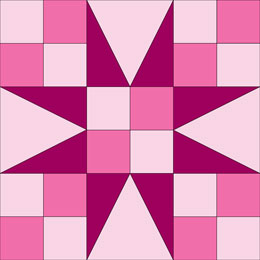Click on the small icons below for a shortcut to the block information.
Sun Rays Quilt
                         Sun Rays Quilt showing diamond shape
Sun Rays Quilt showing diamond shape
 Sun Rays
Kansas City Star, 1939 Sun Rays
Kansas City Star, 1939
 Darting Minnows Darting Minnows
The Kansas City Star published this block in 1939, and columnist Nancy Page (that is, Florence La Ganke) reintroduced it under the name Darting Minnows in 1943.
Like all the other Sun Rays blocks, this one creates an elegant diamond-studded windowpane pattern in a whole quilt. We've added a color to one whole-quilt mockup to show what we mean.
|
|
Judy in Arabia
 Judy in Arabia
Gutcheon Judy in Arabia
Gutcheon
1973
As a whole quilt, the effect is oddly similar to a whole-quilt Storm at Sea: 
|
|
54-40 or Fight
 54-40 or Fight
Stone, 1906 54-40 or Fight
Stone, 1906
 54-40 or Fight 54-40 or Fight /Railroad/Texas/An Old-Fashioned Pinwheel /Railroad/Texas/An Old-Fashioned Pinwheel
Political apathy was not for the quilters of the 19th century, who sometimes named their blocks for political parties and events. "Fifty-four Forty or Fight!" was James Polk's slogan in the 1844 presidential election. He vowed to keep all of Oregon Territory in U.S. hands, rather than Britain's, and he wanted America's northern border clear up to 54 degrees 40 minutes latitude.
If Polk had succeeded, Alaska would be part of the contiguous United States.
Polk won the election, but war with Mexico over the southern border claimed U.S. resources. Polk's diplomacy settled the northern boundary bloodlessly, and permanently, at 49 degrees, where it remains today.
Tennessee Waltz
 Tennessee Waltz Quilt Tennessee Waltz Quilt
 Tennessee Waltz
Stone, 1906 Tennessee Waltz
Stone, 1906
Bouchard combined a three-color variation of 54-40 or Fight with a Snowball block and called it the Tennessee Waltz Quilt. The popular design, part of Eleanor Burns' Quilt in a Day series, brought new life to a block dating back to the 1840s.
Click on the "Make It!" icon to see a YouTube video in which Burns explains how to make the block, and, in Part 2, the quilt.
For the Snowball block, click here: 
Nancy. "The 49th Parallel: the Line Between the US and Canada." WorldAtlas, May. 28, 2019, accessed May 5, 2020.
|
|
Dove at the Window
 Dove at the Window
KCS, 1945 Dove at the Window
KCS, 1945
The graphic at left is not in her suggested colors; she simply used white for the rays and rectangles and prints for the rest. It's laid out on a 12 x 12 grid.
|
|
Prairie Queen
 Prairie Queen Prairie Queen
Wheeler
1938
 Prairie Queen (Wheeler) Prairie Queen (Wheeler)
In the original, the darkest and lightest colors were solids and the others were prints.
|
|
Claws
 Claws
Gutcheon Claws
Gutcheon
1973
|
|
Pineapple Quilt
 Pineapple Quilt
"Aunt Martha" Pineapple Quilt
"Aunt Martha"
1960
The block is drawn on a 5x5-square grid instead of a 9x9, so its paired triangular arms are squished into a space 13 percent smaller than the usual Sun Rays-style block. On the other hand, the triangles do look more like a pineapple's spines that way.
The block is from about 1960, from an Aunt Martha booklet called "Quilt Lover's Delight," per Beyer. |
|
 |
|
 Sun Rays & variations
***
Sun Rays & variations
***
 Sun Rays & variations
***
Sun Rays & variations
***